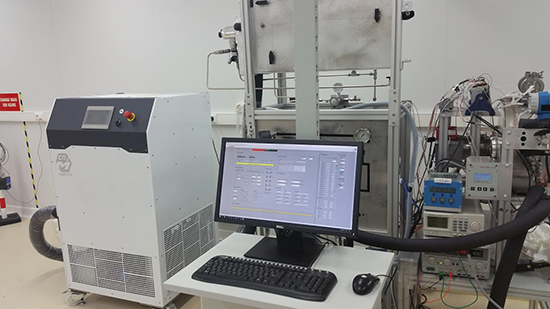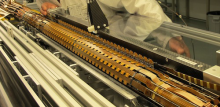MARTA uses CO2 to cool down pixels
The ATLAS team at LAPP has just turned on a compact cooling device that uses two-phase CO2 (made up of a gas phase and a liquid phase). This machine, named MARTA (Monoblock Approach for a Refrigeration Technical Application) will allow LAPP to further its work on pixel detectors.
Pixel detectors in ATLAS are used to detect the passage of charged particles as close as possible to the point of proton collision. The next-generation pixels for the HL-LHC will be 50 by 50 micrometres in size and will be grouped together on rectangular modules of a few centimetres wide where a first processing electronics (Pixel modules) is also attached. To cool down these objects at temperatures between -10 and -40 °C, the CO2 technology appeared about ten years ago. CO2 has advantageously replaced the family of freons that are harmful to the atmosphere and it is already used for ATLAS and LHCb detectors or on the AMS experiment. This CO2 technology is used by the MARTA cooling device. It supplies liquid CO2 under pressure with an adjustable temperature which is then brought to the pixels to cool them.
A long-standing expertise
CO2 expertise in particle physics detectors was initiated at CERN and by the Nikhef laboratory (Amsterdam). The ATLAS group at LAPP is an expert in the use of this technology since the construction of the IBL (Insertable B-layer) between 2007 and 2014. The team has indeed manufactured and implemented a CO2 cooling system in open loop (CO2 is released into the atmosphere after use) as recommended by Nikhef. The CO2 initially at room temperature is cooled, then brought to heating systems mimicking the heat production of pixels and finally released into the atmosphere. Combined with measuring benches built and instrumented by the ATLAS-LAPP technical teams, this system made it possible to measure heat transfer properties in the real operating conditions of a detector. Two ATLAS-LAPP PhD students have succeeded one another in this project with, among other things, the demonstration that Pixel modules can be sufficiently cooled down even with inclined pixels (“alpine geometry”).

This cooling system can consume up to 2 cylinders of CO2 of 34 kg per day during intensive measurement campaigns. To continue the thermal test campaigns under more stable operating conditions and to minimize the amount of CO2 cylinders, it was necessary to switch to closed-loop circulation and cooling to be able to recover the CO2 and cool it again. This is what MARTA allows. It will especially allow, in the years 2020 to 2023, to refrigerate CO2 and then cool down the pixels so it is possible to turn them on and make sure they work well before sending to CERN.
With the widespread use of this technology for the LHC High Brightness program (2026-2037), CERN has partnered with Polish manufacturers to produce such a machine with better performance than the machines already developed internally.
Thanks to Labex ENIGMASS funding for the Pixel program, the ATLAS team was able to equip this new device which is still the only copy at IN2P3. It was started early September 2018 in the ATLAS clean room. Thanks to local expertise, its integration with existing benches will be done quickly to launch the next measurement campaigns this autumn. Other IN2P3 teams have already shown interest in taking advantage of this know-how.
More information:
- The MARTA device: http://icp.mech.pk.edu.pl/martaco2/index.php/2-uncategorised/1-overall-features
- Thumbnail picture: Pixel detector
Contact:


